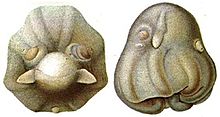Opisthoteuthis medusoides
| Opisthoteuthis medusoides | |
|---|---|

| |
| 1915 drawing of O. medusoides | |
| Scientific classification | |
| Domain: | Eukaryota |
| Kingdom: | Animalia |
| Phylum: | Mollusca |
| Class: | Cephalopoda |
| Order: | Octopoda |
| Family: | Opisthoteuthidae |
| Genus: | Opisthoteuthis |
| Species: | O. medusoides
|
| Binomial name | |
| Opisthoteuthis medusoides Thiele, 1915[2]
| |
Opisthoteuthis medusoides is a cirrate octopus living off the coast of Tanzania near Dar es Salaam.[1] However, its actual range may be more extensive.[2]
The octopus lives 400 m (1,300 ft) deep, where it occupies the benthic zone, or seafloor.[3]
The species is known from only two juvenile octopuses.[4] Both had little pigment. Because of the octopus' medusoid (jellyfish-like) body shape, the species was given the name medusoides. Male opisthoteuthids generally have enlarged suckers on multiple arms; O. medusoides is different, having enlarged suckers on only one arm.[5] "A redescription of this species is badly needed," write Richard E. Young and Michael Vecchione, both scientists who research cephalopods.[6]
References[edit]
- ^ a b Lyons, G.; Allcock, L. (2014). "Opisthoteuthis medusoides". IUCN Red List of Threatened Species. 2014: e.T162946A956344. doi:10.2305/IUCN.UK.2014-3.RLTS.T162946A956344.en. Retrieved 20 November 2021.
- ^ a b "Opisthoteuthis medusoides". World Register of Marine Species. Flanders Marine Institute.
- ^ M.A. Collins; R. Villanueva (June 13, 2006). "Taxonomy, ecology and behaviour of the cirrate octopods.". In Gordon, J.D.M.; Atkinson, R.J.A.; Gibson, R.N. (eds.). Oceanography and Marine Biology: An Annual Review, Volume 44. CRC Press. p. 297. ISBN 9781420006391.
- ^ Jereb, P. (2005). Cephalopods of the World: An Annotated and Illustrated Catalogue of Cephalopod Species Known to Date · Volume 3. Food and Agriculture Organization of the United Nations. p. 256. ISBN 9789251079898.
- ^ NIWA Biodiversity Memoir Issue 112. National Institute of Water and Atmospheric Research (NIWA). 1999. p. 28.
- ^ Young, Richard E.; Vecchione, Michael (May 13, 2003). "Opisthoteuthis medusoides". Tree of Life Web Project.
External links[edit]

